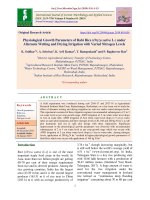Studies on variability, heritability and genetic advance in parental lines of hybrid rice (Oryza sativa L.)
Bạn đang xem bản rút gọn của tài liệu. Xem và tải ngay bản đầy đủ của tài liệu tại đây (408.51 KB, 10 trang )
Int.J.Curr.Microbiol.App.Sci (2019) 8(9): 879-888
International Journal of Current Microbiology and Applied Sciences
ISSN: 2319-7706 Volume 8 Number 09 (2019)
Journal homepage:
Original Research Article
/>
Studies on Variability, Heritability and Genetic Advance
in parental lines of Hybrid Rice (Oryza sativa L.)
Chinnapa Reddy Allam1,3*, T.E. Nagaraja2 and N. Shivakumar3
1
Department of Genetics and Plant Breeding, UAS, GKVK, Bengaluru 560065, India
2
AICRP on Pigeon pea, UAS, GKVK, Bengaluru 560065, India
3
Hybrid Rice Section, ZARS, V.C. Farm, Mandya 571401, India
*Corresponding author
ABSTRACT
Keywords
Variability,
Heritability and
Genetic advance,
Rice
Article Info
Accepted:
15 August 2019
Available Online:
10 September 2019
Genetic variability, genotypic and phenotypic coefficients of variation, heritability and
genetic advance for twenty-one characters in twenty-eight parental lines of hybrid rice
were studied. The analysis of variance revealed highly significant differences for all the
characters among the genotypes. The magnitude of differences between PCV and GCV
was relatively low for all the traits, indicating less environmental influence. The estimates
of genotypic and phenotypic coefficients of variation (GCV and PCV) were high for
spikelets per panicle, flag leaf area, days to 50 % flowering, days to maturity and grain
yield per plant. Heritability and genetic advance were high for all the characters except
pollen fertility which had low genetic advance along with high heritability indicating the
involvement of additive and non-additive type of gene action respectively in controlling
this character.
Introduction
Rice (Oryza sativa L.), belongs to the family
Graminae, recognized as “millennium crop”
expected to contribute towards food security
in the world, as it is one of the staple cereal
crops of the world and a primary source of
food for more than half the world’s
population. With an alarming increase in the
population throughout the world, the demand
for rice will continue to increase in near
future. Therefore, rice breeders across the
world aim at increasing the grain yield of rice.
A better understanding of the relationship
between grain yield and its component traits
becomes necessary for making an efficient
selection for the development of new varieties
with improved economically important traits.
The knowledge of heritability and genetic
variability is a prerequisite for carrying out
selection-based improvement. The information
about these help in the breeding programme
by broadening the gene pool of rice and gives
an indication about the efficiency of
transformation of characters into future
generations respectively. In any crop species
setting the breeding objective to improvement
of crop yield is prime importance.
879
Int.J.Curr.Microbiol.App.Sci (2019) 8(9): 879-888
Understanding of nature and magnitude of
genetic variation governing the inheritance of
relatively quantitative traits like yield and
attributing traits are essential. Plant breeder
has to analyze certain genetic variability
parameters like Genetic coefficient of
variation (GCV), phenotypic coefficient of
variation (PCV), Heritability, and Genetic
Advance of various economic important
quantitative traits to plan future crop
improvement programmes. Genetic variability
plays an important role in study and
identification of promising rice genotypes.
Heritability is the heritable portion of
phenotypic variance. It is a good index of the
transmission of the characters from parents to
offspring (Falconer, 1981). Genetic advance is
also of considerable importance because it
indicates the magnitude of the expected
genetic gain from one cycle of selection
(Hamdi et al., 1992). Hence the present
investigation was undertaken to study the
genetic variability, heritability and genetic
advance in some parental lines of hybrid rice.
Materials and Methods
A field experiment was conducted with 28
parental lines of hybrid rice, developed by
pedigree breeding method, in a Randomized
Block Design with two replications during
kharif 2015 at Zonal Agriculture Research
Station(Z.A.R.S), V. C. Farm, Mandya,
Karnataka. Twenty five days old seedlings
were transplanted with a spacing of 15 cm and
15 cm between rows and plants, respectively.
Five representative plants for each genotype in
each replication were randomly selected to
record observations on days to 50% flowering
[DFF], days to maturity [DM], plant height
[PH] (cm), tillers per plant [TPP], panicles per
plant [PPP], panicle length [PL] (cm), panicle
weight [PW] (g.), spikelets per panicle [SPP],
pollen fertility [PF] (%), spikelet fertility [SF]
(%), test grain weight [TGWT] (g.), grain
yield per plant [GYPP] (g.), flag leaf length
[FLL] (cm.), flag leaf width [FLW] (cm.), flag
leaf area [FLA] (cm2), grain length [GL]
(mm.), grain breadth [GB](mm.), grain L/B
ratio [GL/B], kernel length [KL] (mm.), kernel
breadth [KB] (mm.) and kernel L/B ratio [K
L/B].
The mean of the 28 genotypes were analyzed
statistically by the method outlined by Ostle
(1966). The analysis of variance for different
characters was carried out in order to assess
the genetic variability among genotypes as
given by Cochran and Cox (1950). The level
of significance was tested at 5% and 1% using
F table values given by Fisher and Yates
(1963). Both phenotypic and genotypic
coefficient of variability for all characters as
estimated using the formula of Burton and De
Vane (1953). The broad sense heritability (h2)
was estimated for all characters as the ratio of
genotypic variance to the total or phenotypic
variance as suggested by Lush (1949) and
Hanson (1956). Genetic advance for each
character was estimated by using the formula
of Johnson et al., (1955). Genetic advance as
per cent mean was categorized as suggested
by Johnson et al., (1955).
Results and Discussion
The mean sum of squares for 21 characters in
28 genotypes under study were presented in
Table 1. Analysis of variance revealed highly
significant differences among genotypes for
all the characters studies indicating the
presence of adequate variability among the
genotypes.
The estimates of range and mean were
presented in Table 2. A wide range of
variation was observed in the parental lines of
hybrid rice for all the quantitative characters
and yield. However, widest range of
variability was recorded for spikelets per
panicle (119.78-285.37) followed by plant
height (81.64-131.76 cm) and flag leaf area
880
Int.J.Curr.Microbiol.App.Sci (2019) 8(9): 879-888
(19.56-42.37 cm2). The range of variation
obtained for kernel breadth (1.75-2.5 mm),
grain breadth (2.0-3.0 mm) and panicle weight
(2.16-3.88 g) was least when compared to all
the other characters.
The estimates of genotypic and phenotypic
variance components and coefficients of
variability (PCV and GCV) were presented in
Table 3 and Fig. 1.Variability is essential for
wide adaptability and resistance to biotic and
abiotic factors and hence, an insight into the
magnitude of genetic variability present in a
population is of paramount importance to a
plant breeder for starting a judicious breeding
programme. The phenotypic and genotypic
variances measure the magnitude of variation
arising out of differences in phenotypic and
genotypic values. The absolute values of
phenotypic and genotypic variances cannot be
used for comparing the magnitude of
variability for different characters, since the
mean and units of measurement of the
characters may be different. Hence, the
coefficients of variation expressed at
phenotypic and genotypic levels have been
used. The relative values of these two types of
coefficients give an idea about the magnitude
of variability present in the germplasm
(Lokesh et al., 2013).
(2001), Subbaiah et al., (2011), and Patel et
al., (2014).
The GCV was higher for the characters grain
yield per plant (23.843), spikelets per plant
(20.98) and flag leaf area (19.288). Hence,
these characters are relied upon in stabilized
homozygous population and simple selection
can be practiced for further improvement. The
results are in consonance with Vanisree et al.,
(2013), Subbaiah et al., (2011), Panwar
(2005), Hasib (2005) and in contrast with
Yumnam et al., (2011).
Spikelets per panicle exhibited high genotypic
and phenotypic variances, followed by days to
50 % flowering, days to maturity and grain
yield per plant. Similar results were obtained
earlier by Sawant et al., (1994)and Deb
Choudhary and Das (1998).
The estimates of heritability in broad sense
(h2) and expected genetic advance (GA) and
genetic advance as per cent of mean (GAM)
presented in Table 4 and Fig. 2.High
heritability (broad sense) estimates (>60%)
were recorded for all the characters under
study indicating characters are least influenced
by
environment
and
selection
for
improvement
is
rewarding.
Highest
heritability tillers per panicle (0.99) followed
by test grain weight (0.99), kernel breadth
(0.99). Similar findings are suggested by Mani
et al., (1997), Chand et al., (2005), Panwar
(2005), Hasib (2005),Yumnam et al., (2011),
Sawarker and Senapati (2014), and Dhanwani
et al., (2013); Hasan et al., (2013), found low
heritability for spikelet fertility, are in contrast
with present findings. Since the estimates of
heritability are in broad sense selection based
on heritability alone is misleading hence
another estimate called genetic advance is
used for better prediction of characters under
study.
In general, the values of PCV were higher
than the values of GCV indicating that the
apparent variation is not only due to genotypes
but also due to influence of environment. The
estimates revealed that PCV for all characters
are slightly more than that of GCV indicating
the less influence of environment. Similar
results are found by Shobha Rani et al.,
The high genetic advance revealed by
characters spikelets per panicle (83.74),
followed by plant height (38.07), days to 50 %
flowering (13.94) days to maturity (13.43)
grain yield per plant (13.14) flag leaf area
(12.89) and tillers per plant (11.78) while
other yield traits and all grain dimension traits
exhibited moderate to very low GA values
881
Int.J.Curr.Microbiol.App.Sci (2019) 8(9): 879-888
(Table 4). The values of genetic advance as
per cent of mean (GAM 5%) were high
(>20%) for characters tillers per plant (62.52)
followed by grain yield per plant (48.25),
spikelets per panicle (42.83), flag leaf area
(39.33), panicles per plant (38) panicle length
(36.38), plant height (34.47). However low
GAM (<10%) were revealed by pollen fertility
(5.44).
Table.1 ANOVA for yield and yield contributing characters in rice genotypes
Character Replication Treatment Errror
(d.f=1)
(d.f=27) (d.f=27)
0.662
91.62**
0.62
DFF
DM
0.092
94.32**
0.046
PH
0.053
687.72**
1.485
TPP
1.18
65.8**
0.11
PPP
3.37
18.57**
0.19
PL
0.46
29.135**
0.24
PW
0.17
0.4827**
0.041
SPP
83.69
3394.59**
30.04
PF
0.02
16.801**
3.45
SF
0.036
58.737**
2.047
TGWT
0.065
7.895**
0.039
GYPP
0.923
85.948**
1.522
FLL
2.086
30.189**
0.501
FLW
0.002
0.0244**
0.001
FLA
2.01
80.748**
0.811
GL
0.01
1.044**
0.007
GB
0.034
0.104**
0.012
GL/B
0.002
0.339**
0.001
KL
0.016
0.6154**
0.003
KB
0.012
0.053**
0.002
KL/B
0.003
0.224**
0.001
** Significant at 1% level
882
Int.J.Curr.Microbiol.App.Sci (2019) 8(9): 879-888
Table.2 Range, Mean for different traits in parental lines of hybrid rice
Character
Range
Mean
SE(m)
DFF
88-109
102.03
0.312
DM
116-137
130.03
0.416
PH
81.64-131.76
110.46
0.8618
TPP
9.95-29.35
18.84
0.238
PPP
9.64-22.36
16.26
0.308
PL
14.19-26.45
21.33
0.352
PW
2.16-3.88
3.12
0.144
SPP
119.78-285.37
195.49
3.876
PF
73.56-84.19
79.32
1.315
SF
64.53-88.99
79.82
1.0117
TGWT
13.3-22.22
16.5
0.141
GYPP
16-36.83
27.25
0.872
FLL
21.37-36.09
29.49
0.5006
FLW
1.22-1.66
1.46
0.0089
FLA
19.56-42.37
32.77
0.637
GL
7.02-9.5
7.84
7.84
GB
2.0-3.0
2.42
0.026
2.68-4.65
3.25
0.026
KL
5.1-7.5
6.05
0.041
KB
1.75-2.5
2.03
0.012
KL/B
2.44-4.05
3.04
0.0227
GL/B
883
Int.J.Curr.Microbiol.App.Sci (2019) 8(9): 879-888
Table.3 Genotypic and Phenotypic variance components, coefficient
of variability for different traits
Character Phenotypic Genotypic PCV% GCV%
variance
variance
45.813
45.769
6.639
6.634
DFF
45.741
45.713
5.205
5.205
DM
344.6
343.12
16.805 16.769
PH
32.95
32.84
30.45
30.4
TPP
9.38
9.19
18.83
18.64
PPP
14.69
14.44
17.96
17.81
PL
0.26
0.22
16.407
15.03
PW
1712.32
1682.27
21.16
20.98
SPP
10.13
6.67
4.012
3.256
PF
30.392
28.345
6.906
6.669
SF
3.968
3.928
12.065 12.009
TGWT
43.736
42.213
24.268 23.843
GYPP
15.346
14.844
13.28
13.06
FLL
0.012
0.012
7.553
7.505
FLW
40.78
39.96
19.483 19.288
FLA
0.526
0.518
9.25
9.18
GL
0.052
0.052
9.434
9.434
GB
0.17
0.169
12.691 12.641
GL/B
0.303
0.306
9.182
9.132
KL
0.027
0.027
8.2
8.2
KB
0.123
0.122
11.52
11.47
KL/B
Fig.1 Graphical representation of PCV and GCV
PCV % & GCV %
35
30
25
20
15
PCV%
10
GCV%
5
0
884
Int.J.Curr.Microbiol.App.Sci (2019) 8(9): 879-888
Table.4 Heritability and Genetic Advance for different traits in rice
Character Heritability GA
GA
GAM
GAM
5%
1%
5%
1%
DFF
0.986
13.94
17.86
13.66
17.51
DM
0.984
13.43
17.24
13.16
17.17
PH
0.996
38.07
48.79
34.47
44.17
TPP
0.997
11.78
15.1
62.52
80.13
PPP
0.98
6.18
7.92
38
48.7
PL
0.98
7.76
9.94
36.38
46.62
PW
0.84
0.88
1.13
28.39
36.39
SPP
0.98
83.74
107.32
42.83
54.89
PF
0.65
4.31
5.53
5.44
6.97
SF
0.93
10.59
13.57
13.26
17.04
TGWT
0.99
4.06
5.2
24.6
31.53
GYPP
0.96
13.14
16.85
48.25
61.83
FLL
0.96
7.8
10
26.46
33.91
FLW
0.98
0.22
0.28
15.36
19.68
FLA
0.98
12.89
16.52
39.33
50.41
GL
0.98
1.47
1.88
18.77
24.05
GB
0.99
0.47
0.6
19.43
24.9
GL/B
0.99
0.84
1.08
25.93
33.23
KL
0.98
1.13
1.45
18.71
23.97
KB
0.99
0.33
0.43
16.89
21.64
KL/B
0.99
0.71
0.91
23.53
30.16
885
Int.J.Curr.Microbiol.App.Sci (2019) 8(9): 879-888
Fig.2 Graphical representation of h2 and Genetic advance (5%)
Heritability should be considered along with
genetic advance as per cent of mean, however
it is not necessary that character showing high
heritability will also exhibit high genetic
advance (Johnson et al., 1955). High
heritability coupled with high GAM was
observed with tillers per plant grain yield per
plant, spikelets per panicle, flag leaf area,
panicles per plant, panicle length, plant
height, panicle weight, flag leaf length, grain
L/B ratio, and test grain weight are governed
by additive genes and improvement is
rewarding. Similar kind of results were
obtained by Tirumala rao et al., (2014)
Dhanwani et al., (2013), Vanisree et al.,
(2013), Babu et al., .(2012). However, low
GAM for days to 50% flowering was reported
by Sawarker and Senapati (2014), Tirumala
rao et al., 2014, Seyoum et al., (2012) and
Kole et al., (2008); low GAM for grain yield
per plant was reported by Venkanna et al.,
(2014) and Kole et al., (2008); low GAM for
panicle length was reported by Babu et al.,
(2012), Seyoum et al., (2012), Subbaiah et al.,
(2011) and Kole et al., (2008); moderate
GAM for days to 50% flowering, plant height
and low GAM for panicle length, spikelet
fertility, days to maturity, test weight, grain
yield per plant are reported by Hasan et al.,
(2013).
High heritability coupled with moderate
GAM was observed for characters days to 50
% flowering, days to maturity, spikelet
fertility, flag leaf width, grain length, grain
breadth, kernel length and kernel breadth
indicating characters governed by additive
genes though influenced by environment.
Similar findings are reported by Allam et al.,
(2015), Patel et al., (2014), Dhanwani et al.,
(2013), Vanisree et al., (2013), Subbaiah et
al., (2011).
However Babu et al., (2012) and Subbaiah et
al., (2011) reported low GAM for kernel
breadth; Sawarker and Senapati (2014)
reported low GAM for days to maturity. High
heritability coupled with low GAM is
observed for the character pollen fertility
(table 4) indicating the character is highly
influenced by environmental effects and
selection would be ineffective. From the
present study, it is evident that genotypes
studied may provide good source of material
for further breeding programme. Therefore,
the information on the genetic parameters
886
Int.J.Curr.Microbiol.App.Sci (2019) 8(9): 879-888
such as coefficient of variation, heritability,
genetic advance can help the breeder to
evolve high yielding cultivars.
and Tiwari, J.K. 2013. Genetic variability
analysis for various yield attributing and
quality traits in rice (Oryza sativa L.) The
BioScan, 8(4): 1403-1407.
Falconer, D.S. 1981. Introduction to
quantitative genetics. 2ad edition. Oliver
and Boyd, Edinburg, London.
Fisher, R.A. and Yates, F. 1963. Statistical
tables for biological, agricultural and
medical research. Oliver and Boyd,
London
Hamdi, A. 1992. Heritability and combining
ability of root characters in lentil (Lens
culinarisMedik), Egyptian J. Agric. Res.,
70(1): 247-255.
Hanson, C.H, Robinson, H.F. and Comstock,
R.E. 1956. Biometrical studies of yield in
segregating populations of Korean
lespedza. Agron. J., 48(6): 268-272.
Hasan, M.J, Kulsum, M.U, Akter, A,
Masuduzzaman, A.S.M and Ramesha,
M.S. 2013. Genetic variability and
character association for agronomic traits
in hybrid rice (Oryza sativa L.)
Bangladesh J. Plant Breed. and Genet.,
24(1): 45-51.
Hasib, K. M. 2005. Genetic variability,
interrelations and path analysis for
panicle characters in scented rice. Crop
Res., (Hisar) 30(1): 37-39.
Johnson, H.W, Robinson, H.F. and
Comstock, R.E. 1955. Estimates of
genetic and environmental variability of
soybeans. Agron. J., 47: 314-318.
Kole, P.C, Chakraborty, N.R. and Bhat, J.S.
2008. Analasis of variability, correlation
and path coefficients in induced mutants
of aromatic non-basmati rice. Tropical
Agric. Res. and Extension, 11: 60-64.
Lokesh, B, Reddy, P.S, Reddy, R.V.S.K. and
Sivaraj, N. 2013. Variability, heritability
and genetic advance studies in Brinjal
(SolanummelongenaL.) Electron. J. Plant
Breed.,4(1): 1097-1100.
Lush, J.L. 1949. Heritability of quantitative
characters in farm animals. Proceedings
Acknowledgement
Authors are thankful to Council for Scientific
and Industrial Research (CSIR) for financial
assistance
as
JRF
[grant
no:
09/271(0093)/2016-EMR-I]
for
fulltime
doctoral degree programme at University of
Agricultural Sciences, GKVK, Bangalore 65.
References
Allam, C.R, Jaiswal, H.K, Qamar, A,
Venkateshwarlu, C and Reddy, Y.S.
2015. Variability, heritability and genetic
advance studies in some indigenous
genotypes of basmati rice (Oryza sativa
L.). Electron. J. Plant Breed.,6(2): 506511.
Babu V.R, Shreya K, Dangi K.S, Usharani G
and Nagesh P. 2012. Genetic variability
studies for qualitative and quantitative
traits in popular rice hybrids of india.
Internat. J. Scientific and Res. Public.,
2(6) ISSN: 2250-3153
Burton , G.W. and Devane, E.M. 1953.
Estimating
heritability
in
fescue
(Festucaarundinaceae) from replicated
clonal material. Agron. J., 45: 478-481
Chand, U., Katoch, P.C. and Vijay Kumar.
2005. Variability studies in some
macromutations induced by EMS and
gamma rays in Basmati rice T-23. Annals
of Biol., 21(2): 137-141.
Cochran, G. W. and Cox, M.G. 1950.
Experimental designs. John wiley and
sons, Newyork.
Deb Choudhary P.K. and P.K. Das Genetic
variability,
correlation
and
path
coefficient analysis in deep water rice.
Ann. of Agric. Res. 19(2): 120-121
(1998).
Dhanwani, R.K, Sarawgi, A.K, Solanki, A,
887
Int.J.Curr.Microbiol.App.Sci (2019) 8(9): 879-888
of
8th
congress
of
genetics,
Heriditas.,3(1): 356-375.
Mani, S.C, Verma, S.K. and Sharma, R.K.
1997. Genetic variability and character
association for panicle traits in Basmati
rice. Agric. Sci. Digest, 17(3): 155-157.
Ostle, B. 1966. Statistics in research 1st
edition, Oxford and Indian Book House
Private Limited, New Delhi. Paikhomba,
N, Kumar, A, Chaurasia, A.K. and Rai,
P.K. 2013. Assessement of genetic
parameters for yield and yield
components in hybrid rice and parents. J.
Rice Res., 2(1): 117.
Panwar, L.L. 2005. Genetic variability,
heritability and genetic advance for
panicle characters in transplanted rice.
Res. on Crops, 6(3): 505-508.
Patel, J.R, Saiyad, M.R, Prajapati, K.N, Patel,
R.A. and Bhavani, R.T. 2014. Genetic
variability and character association
studies in rainfed upland rice (Oryza
sativa L.) Electron. J. Plant Breed.,5(3):
531-537.
Sawant D.S., S.L. Patil and S.G. Bhave
Variability, heritability and genetic
advance in pure lines of lowland rice.
Annals of Agric. Res. 15(1): 27-30
(1994).
Sawarkar, A. and Senapati, B.K. 2014.
Polygenic variations and cause effect
relationship in some photo-insensitive
recombinant inbred lines (RIL’s) of
Basmati
derivative.
African
J.
Biotechnol., 13(1): 112-118.
Seyoum, M, Alamerew, S and Bantte, K.
2012.
Genetic
variability,
heritability,correlation and path analysis
for yield and yield related traits in upland
rice (Oryza sativa L.) J. Plant Sci., 10:
3923/jps.2012.
Shobha Rani, N., Rama Prasad, A. S., Prasad,
G. S. V., Bhaskara Reddy P. and Krishna
Veni, B. 2001. Genetic variability for
yield component in aromatic and quality
rice germplasm. Indian J. Plant Genet.
Resource ,14: 206-209.
Subbaiah, P.V, Sekhar, M.R, Reddy, K.H.P.
and Reddy, N.P.E. 2011. Variability and
genetic parameters for grain yield and its
components and kernel quality attributes
in CMS based rice hybrids (Oryza sativa
L.) Internat. J. Appl. Biol. and
Pharmaceutical Technol., 2(3): 603-609.
Tirumala rao, V, Mohan, Y.C, Bhadru, D,
Bharithi, D. and Venkanna,V. 2014.
Genetic variability and association
analysis in Rice. Internat. J. Appl. Biol.
and Pharmaceutical Technol., 5(2): 6365.
Vanisree, S, Anjali, K, Damodar Raju, CH,
Surender Raju, CH, and Sreedhar, M.
2013. Variability, heritability and
association analysis in scented rice. J.
Biological Sci. Opinion, 1(4): 347-352.
Venkanna, V, Lingaiah, N, Raju, CH.S, and
Rao, V.T. 2014. Genetic studies foe
quality traits of F2 population in rice
(Oryza sativa L.). Internat. J. Appl. Biol.
and Pharmaceutical Technol., 5(2): 125127.
Yumnam,
S,
Nandeshwar,
B.C,
BijanAdhikari, Senapati, B.K. 2011.
Variability and Character association in
recombinant lines F6 of basmati
derivative. Curr. Advan. in Agric. Sci.,
3(1): 24-28.
How to cite this article:
Chinnapa Reddy Allam, T.E. Nagaraja and Shivakumar, N. 2019. Studies on Variability,
Heritability and Genetic Advance in parental lines of Hybrid Rice (Oryza sativa L.).
Int.J.Curr.Microbiol.App.Sci. 8(09): 879-888. doi: />
888
![Chemical and functional components in different parts of rough rice (oryza sativa l[1] ) beforeandaftergermination](https://media.store123doc.com/images/document/14/rc/qa/medium_qab1394872940.jpg)
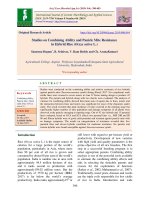
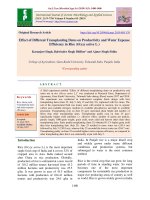


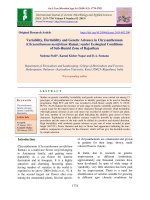

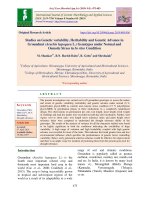
![Studies on genetic variability, heritability and genetic advance in F2 segregating population of Cross Arka Archana × AAC-1 in China Aster [Callistephus chinensis (L.) Nees]](https://media.store123doc.com/images/document/2020_01/14/medium_pyb1578991636.jpg)
